|
|
 |
TREKCORE >
GAMING >
STARFLEET COMMAND III > Weapons
The
following weapons are used in Starfleet Command 3:
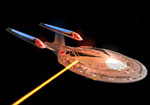 |
In the
early ages of interstellar travel, it became clear that
directed energy devices would be needed in order to
assist in clearing gas, dust and other microscopic
materials from the flight paths of vehicles. A way was
found to deflect these materials by using directed
energy. It soon became apparent that such technology
could also make an effective weapon system, and the
phaser was conceived.
Current Federation ship-mounted phasers range in power
from the Phaser Type IX (the weakest ship-mounted
phaser) to the Type XII (the most powerful ship-mounted
phaser). Each phaser class has both a fast and slow
firing variant. Fast-firing phasers are less powerful
than their slow-firing counterparts, but recharge more
quickly. Phaser energy dissipates over distance,
resulting in a loss of efficiency and damage at long
range. This, combined with the phaser’s high accuracy,
makes it an ideal short-range weapon. |
 |
|
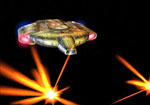 |
Phasers
proved effective against most vessels in the early
history of space travel. However, as warp drive became
more prevalent, the need arose for a weapon deliverable
at high relativistic and warp speeds. Initially,
rudimentary nuclear projectiles were used for this
purpose. After much research, Starfleet engineers
perfected the controlled detonation of matter and
antimatter and fitted the new technology into a torpedo
casing with an advanced propulsion system. The result
was the photon torpedo, which immediately became the
standard heavy weapon on all Federation vessels. Though
the design has been upgraded since its inception, the
basic configuration remains the same on even the most
advanced vessels.
The Klingon Empire was experimenting with
matter/antimatter weaponry at the same time as the
Federation, and their weapons were very similar to those
of Starfleet. However, their weaponry was developed with
a slightly higher yield and fewer safety precautions.
Since then, the two empires have shared technology to
the point where the two systems are identical on current
vessels. Photon torpedoes can be armed with Proximity
fuses, which detonate when the weapon gets close to an
enemy vessel instead of on impact. This increases the
probability of hitting a fast-moving target, but
significantly reduces the amount of damage inflicted. |
| |
|
 |
As the
photon torpedo reached what many Starfleet researchers
agreed was its highest possible explosive yield, a group
of engineers at the Starfleet R&D facility on
Groombridge 273-2A began investigating methods for
achieving a higher release of energy from a projectile
of equal dimensions to the photon torpedo. The result
was the quantum torpedo, which utilizes an
eleven-dimensional, space-time membrane suspended in an
ultra-clean vacuum within the projectile. The membrane
is twisted into a string and then isolated from the
background vacuum. This results in the creation of a new
particle, which is accompanied by a tremendous release
of energy.
The quantum torpedo is a heavy weapon available only to
Federation vessels. It does significantly more damage
than the photon torpedo. Like the photon torpedo, it can
be set to proximity detonate. |
| |
|
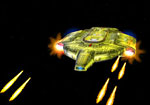 |
The pulse
phaser was developed by Starfleet as a weapon to combat
future Borg incursions and was first fitted onto the
prototype U.S.S. Defiant. The device functions similarly
to a standard phaser, but without a continuous beam. The
energy emissions are instead stored in a magnetic field,
allowing them to coalesce and agitate to higher energy
states. The field is then re-directed, forcing the burst
of phaser energy toward the target. This process is
repeated rapidly using multiple magnetic field
generators, and the result is a stream of phased energy
projectiles. Although the range of such a weapon is much
less than the standard phaser due to rapid dissipation,
from close range the pulse phaser can do far more damage
than a standard beam phaser. The weapon has been adapted
to function on most Federation ships. |
| |
|
 |
The
space mine is, at its heart, a matter/antimatter warhead
designed to detonate when a vessel reaches a certain
proximity to it. It functions in much the same way as
the Federation photon torpedo. These mines utilize a
detonation device that releases controlled amounts of
matter and anti-matter, which annihilate and cause a
massive energy release. Although the effectiveness of
mine fields in the vastness of space is minimal, mines
have been used to great effect in close quarters
starship combat or to distract and damage pursuing
vessels. |
| |
|
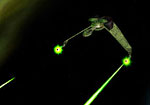 |
Early
Romulan spacecraft were equipped with basic projectile
weapons, which were largely ineffective at high speeds
and long range. As their technology grew, the Romulans
realized (as Starfleet later would) that the same
directed energy fields used to deflect particles of dust
in the path of their vessels could be amplified and used
as an effective weapon. The standard disruptor functions
very similarly to the phaser, although it is often fired
in pulses as opposed to beam form.
A brief Romulan-Klingon alliance around 2268 resulted in
disruptor technology being shared with the Klingon
Empire. Although they have upgraded the disruptor to
their own specifications since then, the two weapons
remain largely identical. Disruptors are available in
strengths from 1 (weakest) to 4 (strongest), and each
level is available with a normal or faster firing rate.
The faster firing rate requires more energy. |
| |
|
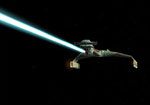 |
The ion
cannon is similar to the Romulan plasma torpedo,
although instead of the highly unstable and dangerous
plasma, it uses a stream of highly ionized gas suspended
in a magnetic field and hurled at the target. The
resultant explosion is not nearly as damaging as the
plasma torpedo, but requires far less energy to fire and
is much less likely to overload. As the ionized gas
travels through space it dissipates, giving the ion
cannon a much shorter range than a torpedo-based weapon.
However, at close range, the ion cannon can do more
damage than torpedoes. |
| |
|
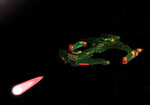 |
The polaron
weapon was developed by the Klingons in an effort to
create a torpedo-based weapon to keep pace with the
Federation’s research into quantum torpedoes. Although
the explosive discharge is not much greater than a
standard photon torpedo system, the delivery system has
been vastly upgraded to include a modulating polaron
radiation generator. This surrounds the torpedo in a
field of polaron emissions, which are constantly
changing modulation. This allows the torpedo to pass
through most forms of energy shielding in use today in
order to impact directly on the target’s hull. The
upgrade also provides the torpedo with a slightly
increased range.
The polaron torpedo charges at a rate equal to the photon
torpedo, but it has a slightly longer range. Each
torpedo has a chance to bypass an enemy’s shields and
damage their hull directly. |
| |
|
 |
The tachyon
pulse was developed by Klingon scientists in an effort
to prevent opponents from fleeing battle, a tactic
deemed dishonorable by the Klingons. It utilizes a burst
of tachyons, particles that can only exist at
faster-than-light speeds. This tachyon burst is
dissipated as soon as it comes into contact with an
enemy vessel, but the resultant sub-space disturbance
caused by the sheer number of particles makes the
formation of a warp field impossible for a short period
of time. The tachyon pulse renders warp drive inoperable
and prevents the enemy from fleeing battle. This
technology has spread to other empires, which have
adapted it for use on their own vessels. |
| |
|
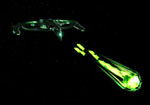 |
Plasma is a
highly unstable form of matter in which a gas has become
so hot, its electrons have been stripped away from the
atomic nuclei. The result is matter on the verge of
becoming pure energy. While most races have abandoned
research into plasma-based weaponry because of the high
risk involved, the Romulans ignored precautions and
developed the highly destructive plasma torpedo. The
device generates a ball of plasma using a burn process
similar to the one used in impulse engines (which
generate plasma as a byproduct). This plasma is
suspended in a magnetic field and hurled at a target. On
impact, the plasma ignites and a massive amount of
energy is released. Early plasma weaponry degraded
seriously over distance and traveled quite slowly.
Recently, based on intelligence on zero-point,
clean-vacuum energy fields stolen from Federation
sources, the plasma torpedo has been upgraded to deliver
a higher speed and greatly increased effective range.
Plasma torpedoes are available in three strengths: light,
medium and heavy. They are very slow to recharge and
require large amounts of energy to maintain, but they
are the most powerful heavy weapon available to any
race. |
| |
|
 |
Utilizing
technology discovered on a salvaged Dominion vessel,
Romulan researchers developed the myotronic beam. The
weapon does a fairly high amount of damage on its own,
but a side effect of its enhanced energy field is the
creation of a field of electromagnetic particles. These
particles interfere with the energy buildup typical of
most weapon designs. The result is that the enemy’s
weapons are unable to fire for a short period of time
after being struck.
The myotronic beam charges faster than a plasma torpedo
launcher, but has a shorter range. A successful hit will
damage the target, and has a chance to stun its weapons
systems for a short period. |
| |
|
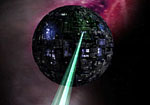 |
Little is
known about the genesis of Borg weaponry, but many races
in the galaxy have been unfortunate enough to see the
effectiveness of the Borg cutting beam in action. The
beam damages a vessel’s shields and will eventually cut
through them and into the hull of the enemy ship.
Primarily used by the Borg to dissect and analyze enemy
ships for possible technological assimilation, it has
also proven to be a powerful weapon.
The cutting beam is available in light, medium and heavy
versions. Higher-end beams do more damage, but require
more power to maintain. |
| |
|
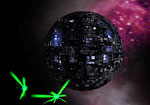 |
Although
the Borg are primarily concerned with the assimilation
of other worlds, they are occasionally tasked with
defending themselves against those who don’t wish to be
assimilated. To adapt to this situation, they developed
the gravimetric torpedo. This projectile weapon utilizes
an advanced graviton inversion field to cause a
gravimetric shear in its target, causing severe
structural damage.
The gravimetric torpedo does more damage than the standard
photon torpedo and requires equal energy to maintain. |
| |
|
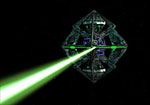 |
Depletion
of an enemy’s shields is crucial to the assimilation of
a ship and its crew. Damage to the hull of a vessel
risks the destruction of viable technology. The Borg
have adapted the shield inversion beam to aid them in
combating shielded enemies. While most weapons damage
only the shield facing they strike, the shield inversion
beam damages all of an enemy’s shields at once. The
result is that the shields are weakened equally. This
makes lowering an opponent’s shields for boarding
easier, as the enemy cannot maneuver their stronger
shields toward the attacker.
The Borg shield inversion beam charges slightly faster
than the gravimetric torpedo, but has a shorter range. A
successful hit will deplete all of the enemy’s shield
facings equally. |


|
|



